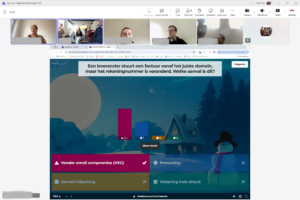Personalized learning in higher education with an advanced digital portfolio
In recent years, the demand for personalized and flexible education in higher education has grown rapidly. Both universities and universities of applied sciences are rethinking how students learn and show their progress.
Traditional portfolios, where students simply upload assignments, are no longer enough. Many programs now need a new kind of portfolio — one that supports continuous learning, reflection, and feedback. Several studies confirm this growing trend in education (1,2).
Shift in learning
Another major shift is the focus on workplace and practical learning. Learning doesn’t just happen in classrooms anymore. It happens on the job, during projects, and in internships.
Technical programs, for example, often use challenge-based learning: students work on real-world problems and learn by doing. This approach has already proven successful in fields like healthcare and business (2).
Personalized learing
Experts agree that personalized learning is key to meeting each student’s needs, talents, and learning style. A well-designed digital portfolio can make this possible — but only if it’s built the right way.
Not every digital portfolio supports personalized learning effectively. Institutions face several challenges when selecting and implementing such systems (1,4).
Later in this article, we’ll explore which features and functionalities help create a truly personalized learning journey.

Access for External Parties
In workplace learning, flexibility is key. A digital portfolio must allow external parties—such as internship supervisors and assessment committees—to easily give feedback and evaluate students’ work.
This is especially important in universities of applied sciences, where internships and hands-on projects are central to learning. Companies and institutions need simple, secure access to view and assess students’ portfolios.
In academic education, external access is just as relevant. Examination boards, research partners, and even potential employers should be able to review a student’s portfolio. It serves as a digital business card that showcases skills, growth, and achievements.
User friendly and secure
For this to work, a portfolio platform must offer user-friendly access for external assessors—without creating extra workload for the institution. Some programs work with hundreds of external evaluators, so managing access must be effortless and scalable.
At the same time, access must remain secure and traceable. The system should clearly record who provided feedback or completed an assessment. This ensures both accountability and data security.
Alignment with learning and assessment vision
A digital portfolio must fit seamlessly with the program’s learning and assessment vision. It should reflect how students learn, develop, and are evaluated — both within the institution and in the professional field.
In medical education, for example, many programs already use programmatic assessment supported by e-portfolios. For these programs, a digital portfolio designed specifically for this approach is essential.
Multiple frameworks
Other programs still rely on more traditional assessment methods. For them, a portfolio may serve a different purpose — for instance, as a developmental tool alongside standard exams and evaluations.
An effective portfolio should therefore adapt to different educational models. Whether a program is built around learning outcomes, competencies, or Entrustable Professional Activities (EPAs), the portfolio must support each approach with equal ease.
Ideally, a modern portfolio system can even combine multiple educational frameworks at once. This flexibility allows institutions to evolve their learning and assessment strategies without needing to change systems.
Successful implementation and adoption
A digital portfolio can only make an impact if it is successfully implemented and adopted by teachers and students. This requires clear planning, training, and ongoing support. Both groups need time to get familiar with the new learning approach and digital environment — a process that often proves challenging in practice.
Research shows that a step-by-step rollout, combined with strong guidance, greatly increases the chances of success. Involving teachers and students early in the process also helps build ownership and engagement (1,4).
Close collaboration between the institution and the supplier is essential. The supplier’s understanding of educational design plays a key role in translating the program’s learning and assessment model into an effective portfolio setup.
From our experience, introducing a digital portfolio is not just a technical project — it’s a change management process. The right expertise and experience with implementing portfolios in complex educational environments can make all the difference.
Read more in the article ”Succesful implementation and adoption of a digital portfolio: 5 do’s”
Integration with the Digital Learning Environment
A digital portfolio should never stand alone. It must be seamlessly integrated with the institution’s existing digital learning environment. Students and teachers need a single, connected ecosystem where learning, assessment, and feedback come together.
Smooth integration with learning management systems, scheduling tools, and assessment software is essential. Only when these systems work together can the portfolio truly function as a powerful instrument for personalized learning (2,3).
That may sound obvious — and it is — but in practice, integration often falls short. Sometimes systems simply can’t connect. As a result, data ends up scattered across platforms, making it harder to get a complete picture of a student’s progress. When that happens, students may not receive the right support at the right time.
What functionalities are needed for personalized learning?
Research has shown that the chances of success increase significantly if certain conditions are met:
- Adjusting learning goals and activities
Teachers can adapt learning goals and associated learning activities per student in the portfolio to their specific level, interest, and learning needs. - Formative evaluation and tailored feedback
By closely monitoring students’ portfolio submissions and progress, teachers can provide targeted, personal feedback that aligns with each individual student’s learning needs. - Choices for students
A powerful aspect is that students make choices within the curriculum in their learning activities, work forms, and ways of learning. - Flexible learning routes and paths
With the flexibility of a digital portfolio, universities can easily set up different learning paths and choice trajectories, tailored to the preferences, talents, ambitions, and learning speeds of individual students. - Live monitoring and adjustment
The clear dashboard gives teachers current insight into the progress, development, and bottlenecks of each individual student. - Individual timing and location of learning activities
In addition, in our own practice and especially in medical education, we see the importance of being able to do learning activities individually in time and place as opposed to classical classroom learning. After all, in practice, you don’t often have a say in what will happen. And certainly in a healthcare facility or hospital this is the case. So for setting up the portfolio, it is then necessary that the actions or assignments with the corresponding feedback or assessment form can be easily changed by the institution. - Flexibility at the process level
Finally, in order to facilitate all of the above points at the process level, you must also be able to be very flexible. For example, the programmatic testing concept works with many different forms such as low-stake and high stake assessments, self-reflections, group feedback, 360 degree feedback and many other processes. This is because the specific learning situation requires a specific feedback form, content and process.
Conclusion
Through these extensive functionalities for differentiation and personalization, an advanced digital portfolio makes it possible to shape higher education around the individual student. Students gain more control over their own learning process and can follow a learning path that seamlessly aligns with their personal needs, possibilities, and ambitions.
Thus, a well-implemented digital portfolio optimally supports universities in realizing personalized learning. A promising development for high-quality and future-oriented higher education, in which customization and talent development are central.
Sources to this article
- Invoeren van een digitaal portfolio in het hoger beroepsonderwijs (utwente.nl)
- https://www.surf.nl/files/2023-09/sf-e-portfolio_def.pdf
- surf-rapport-herijking-van-de-visie-op-de-digitale-leeromgeving_webversie_0.pdf
- Surfen over glad ijs; ICT-implementatiestrategieën in het hoger onderwijs vanuit veranderkundig perspectief (hal.science)



